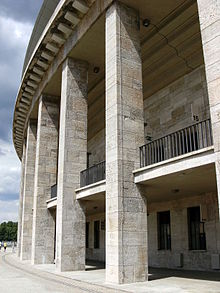Kirchheim shell limestone

The Kirchheimer Muschelkalk (also called Franconian Muschelkalk ) is a natural stone that occurs near Kirchheim , about 15 km south of Würzburg in Lower Franconia . Geographically, it is a rock that was formed during the Upper Muschelkalk period. There are three types of natural stone, which differ in their properties: core stone , gold bench and blue bench (the latter also known as blue bench stone ).
Occurrence and mining
The distribution area of this limestone deposit extends from Kirchheim and Gaubüttelbrunn , Kleinrinderfeld , Heidingsfeld , Marktbreit , Ochsenfurt , Randersacker , Rothenburg ob der Tauber , Krensheim to Grünsfeld .
The thick and 5 to 13 meter high, mighty limestone strata has an inner core area in which there is no or hardly any clay in the rock, but only in the form of stylolites , as separating layers between the rock banks. In the edge area, which is about 7 kilometers wide, clay was deposited not only in the separating layers, but in the rock itself.
Kirchheim shell limestone was formed in a sea basin that was populated by animals and plants that died off. The shells, housings and plant relics were made of lime, were partially smashed and also formed lime sludge and petrified. Iron hydroxides were washed in from the surrounding coastal regions of the sea and sedimented in the lime mud. The natural stone was colored differently in layers from the iron oxides that were washed in, which is why there are different colored varieties.
The Kirchheim limestone was of great economic and cultural importance for this region and there were numerous quarries. In the vicinity of its occurrence, this natural stone has shaped entire landscapes and buildings in the towns. This limestone was mainly used in the first half of the 20th century and is still used throughout Germany in 2008.
The reduction in quarries takes place through a vertical wedging the rock layers corresponding to the desired formats of the ingots and using loader shovels that lift the ingots. This is done using the horizontal clay deposits that separate the rock layers, and in this way the raw block extraction can be operated with relatively little effort.
Core stone
The core stone is a gray-brown limestone made from mussel and brachiopod shells . Fossils and fossil fragments are clearly visible to the eye. The shells reach a thickness of 5 millimeters and peloids , small oval bodies with a grain size of 0.1 to 0.2 millimeters are embedded. The binder is calcitic with a share of 27 percent and the components have a share of 73 percent. The biogenic components make up 87 percent and the peloids 13 percent.
The core stone is weatherproof and can be partially polished. Due to the current environmental conditions, the polish will wear off after being outdoors for a long time and it will fade easily.
Kernstein was installed at the Isarbrücken, Stadtsparkasse am Isartorplatz, Neptunbrunnen and in the Theresienstraße underground station in Munich, the Spanish Embassy in Berlin and Deutsche Bank AG in Düsseldorf .
Gold bank and blue bank

The natural stone types Goldbank and Blaubank differ only in their color, there are marginal differences in the technical values and in the mineral inventory. According to Grimm , the gold bank is often the oxidized product of the blue bank.
The gold bench is beige-gray in color and the blue bench is blue-gray. The gold bank has oxidized iron compounds in its lime mass, so it appears slightly golden. The components of mussel and brachiopod shell shells are 53 percent and the binding agent is 47 percent. In addition to Schill , peloids are included. In the components, the biogenic share is 88 and the peloids are 12 percent.
The gold and blue banks are good to moderate and not as weatherproof as the core bank. They can be polished and will fade after a relatively short time outdoors. They are better suited for interior work.
The two varieties were installed on the Max Emanuel Monument, at the university and at the Munich Regional Church Office, and in very large quantities in the Berlin Olympic Stadium .
Extraction and use
All of the above natural stones are used for monumental buildings, flat and profiled stone , house bases, monuments and tombs, stone carving work as well as floor and wall panels.
literature
- W. Dienemann and O. Burre: The usable rocks of Germany and their deposits with the exception of coal, ores and salts, Enke-Verlag, Stuttgart 1929, p. 373f.
- Karlfriedrich Fuchs: Natural stones from all over the world. Discover, determine, apply . Callwey, Munich 1997, ISBN 3-7667-1267-5 .
- Wolf-Dieter Grimm: picture atlas of important monument rocks of the Federal Republic of Germany. Edited by the Bavarian State Office for the Preservation of Monuments, Lipp-Verlag, Munich 1990, ISBN 3-87490-535-7 , rock no. 169 u. 170.
Web links
- Kirchheimer Muschelkalk at the Fraunhofer Information Center for Space and Building (IRB), Stuttgart.
Coordinates: 49 ° 39 '56 " N , 9 ° 51' 56" E


